SilverStone SX500-G Power Supply Review
Pros
Cons
Rating
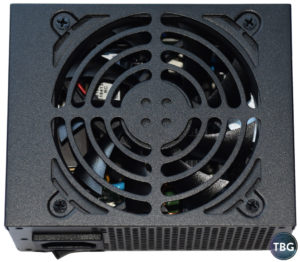
Here at The Tech Buyer’s Guru, we take a slightly different approach to reviewing power supplies. We don’t have (and do not intend to purchase) the advanced load testing equipment required to assess the electrical properties of power supplies. In part that’s because we only review high-end, high-quality units (read: no bargain-basement offerings!), so we operate under the assumption that these units will conform to their specifications and pass all the required efficiency, voltage regulation, and hold-up time tests required to achieve their particular “80 Plus” certification. In fact, unlike so many other components in the PC industry, power supplies are actually very well regulated, which means it’s hard to get a real lemon. And that’s a good thing, because a bad power supply can take down an entire system pretty quickly.
So in this review of the new SilverStone SST-SX500-G SFX Power Supply, we’re going to focus on relative efficiency, fan operation, noise, ease of use, and overall value. The last power supply we reviewed was SilverStone’s SX700-LPT 700W Platinum-rated SFX-L power supply. Offering up 700W and Platinum efficiency in an extended SFX format, it was very impressive, but it also came at a steep price. SilverStone is targeting the new SX500-G at a much broader market, and it’s likely hoping it will sell in much greater numbers. It’s a major update to the old ST45SF-G 450W Gold model, which has been around for what seems like ages (OK, five years to be exact), and was among the very first modular SFX units ever released. We view the SX500-G as the replacement for that model, but perhaps for the extended SX500-LG as well, which helped pioneer the SFX-L format when it launched in early 2015. We’ll be using the SX500-LG V2 as the reference model for our testing in this review.
We’d like to extend a special thank you to SilverStone for providing us a review sample of the SilverStone SX500-G.
Description and Features
First off, being an SFX power supply, which is tiny, at just 125mm wide, 63.5mm tall, and 100mm long. The only dimension that differs from SFX-L models, like the SX500-LG that we’ll be comparing it to throughout this article, is in length; SFX-L models are 130mm long, which allows them to use 120mm fans. To bridge the difference without enlarging the chassis, the SX500-G moves from the 80mm fans used in SilverStone’s previous SFX units to a larger 92mm fan, which marks the biggest visual difference in this model.
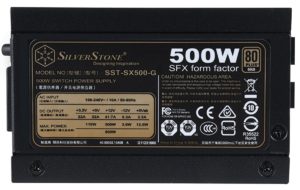
Interestingly, despite being a pioneer in the SFX arena, SilverStone was not the first manufacturer to jump up to 92mm fans in SFX power supplies. That honor goes to Corsair, which released its class-leading SF450 and SF600 back in March of 2016. SilverStone actually showed off a prototype of its competing unit earlier, at CES in January 2016, and you can see a photo of this prototype in TBG’s coverage of the event. Alas, it’s taken a year and a half to bring it to market, and according to SilverStone’s representative Tony Ou, part of the delay came down to SilverStone working very closely with OEM manufacturer High Power to make sure that the SX500-G surpassed the performance of Corsair’s offerings.
Of course, the SX500-G also needed to contend with its in-house competition, in the form of the SX500-LG (the 5-year-old 450W and 600W SFX units are really no longer viable alternatives, from our point of view). The SX500 improves upon its larger cousin in a number of ways. First, it has 41.7A on the 12V rail versus 40A, for a true 500W on the 12V rail (up from 480W). That translates to an amazing 630W/liter, up from 484W/liter. It also has enhanced over current protection, as well as vastly improved connectors. The one that stuck as most interesting is the 4-pin “Sense” input, and we’ll let SilverStone explain this one:
The separate 4pin sense connector is to improve voltage regulation. Without it, the PSU will still work fine but regulation will drop by about 1% ~ 2%, not a big deal for 99% of users but matters a lot in PSU reviews where a couple of percentage points could mean the difference between first place on the chart and middle of the pack.
As we said in the introduction, we don’t actually test things like voltage regulation, but we wanted to point this out to show just how far SilverStone has gone to move the SFX standard forward.

The SX500-G also adds a third SATA/peripheral output, allowing it to power a total of six SATA devices and three peripheral devices simultaneously. Instead of one PCIe cable with dual 6+2 pin connectors, it has two PCIe outputs, with each cable having just one 6+2-pin connector. This change makes sense given that Nvidia has moved to the 8-pin standard for many of its latest video cards, rather than dual 6-pin connectors (both are capable of supplying 75W). Thoughtfully, SilverStone has put one of these PCIe connectors on a 400mm cable, while the other is on a 550mm cable. This corresponds to the reality than in an SLI setup, one video card is always going to be further away, and more importantly, that most SFX power supplies are used in ITX systems, where a shorter cable is actually an asset. Below you can see all of the cables included with the SX500-G, minus the floppy/Berg connector that we’re sure no one will be using!
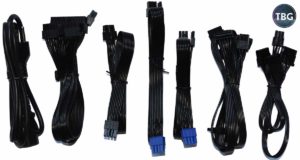
Of note, the SX500-G doesn’t have a “zero-RPM” or “hybrid fan” mode, which would allow the fan to turn off at very low loads. Interestingly, the Corsair SF series, which uses a similar 92mm fan, does have this feature, and its fan only turns on when power draw reaches 20%. Our guess is that SilverStone determined that the frequent noise fluctuations caused by surpassing a similar threshold (100W in the case of the SF500-G) would be more distracting to the user than simply keeping the fan spinning at all times. Update: SilverStone has confirmed to us that avoiding the constant on/off cycling reduced perceived noise for the user.
In a chassis as small as the one used for SFX units, this is probably the safest approach – there’s just not a lot of room for heat to dissipate on its own otherwise. Alas, there may be another reason for this approach. We’re sorry to have to bring this up, but SilverStone has had a bit of a rough go of it when it comes to zero-fan RPM modes. The original SX500-LG SFX-L unit offered this feature, but it turned out to be defective. The fan would engage at an RPM level that was under its rated range, meaning it was operating below proper voltage, causing it to tick wildly. User reports and complaints ran rampant on the Internet, and SilverStone eventually caught on to the problem and updated the SX500 to version 2, which eliminated the zero-RPM mode. While this did indeed lead to an improvement in the overall noise profile (we RMA’d our original-issue SX500-LG for a v2 model), the fan was unfortunately not particularly quiet at its lowest rated RPM level, which is probably what got SilverStone in that mess in the first place.
One last thing we should mention is the warranty. While SilverStone has not yet published a warranty for the brand-new SX500-G, based on the precedent set by other Gold-rated models, we expect it to be three years. This seems a bit short in light of the “warranty arms race” currently gripping the PSU industry, with many major players bumping their standard warranties up to ten years. As some commentators have mentioned, doing so on a component that undergoes significant stress and can be abused by certain users (read: cryptocurrency miners) comes with its own risks, namely inundating RMA departments with potentially improper warranty claims. That being said, we do hope SilverStone will choose to back this unit up with a 5-year warranty, which it applies to its Platinum and Titanium product lines. We believe that this would be reasonable given this unit’s pricepoint and the fact that it’s an unlikely candidate for an extreme gaming or mining rig. Update: SilverStone has confirmed to us that the SX500-G is covered by a 3-year warranty.
OK, on to our performance-related metrics and conclusion!
Performance
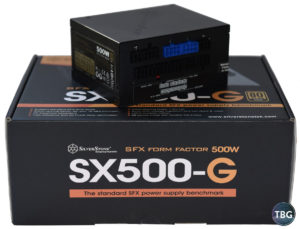
We always make it a point to test products in a real-world setup like those our readers might be using. We don’t use open test benches or stands, and we don’t use the same huge ATX case to test every component, from low-profile coolers to dual video cards in SLI. As we like to say, it’s important to choose the right tool for the right job, and testing a product in a scenario that doesn’t replicate its real-world application may overstate strengths or hide weaknesses.
So, with that in mind, here’s the system we used to test the SX500-G:
- CPU: Intel Core i7-4770K
- Motherboard: AsRock Z97E-ITX/AC
- Video Card: EVGA GeForce GTX 1080 8GB Founders Edition
- RAM: Crucial 2x4GB Ballistix Sport VLP DDR3-1600
- Solid State Drive: OCZ Trion 150 960GB
- Case: Silverstone Raven RVZ02B-W
- Optical Drive: Samsung Internal Slim DVD Burner
- CPU Cooler: Reeven Steropes
- Operating System: Windows 10
We originally built this system up for our High-End ITX Assembly Guide, which used the SX500-LG ver. 1 power supply. While we thought the RVZ02 case was quite an impressive showcase of the SFX-L form factor, the power supply itself was not all we had hoped it would be, as discussed on the previous page. While the SX500-LG V2 that we’ve been using in this test system was in improvement, it still wasn’t perfect, as you’ll see in the benchmarks.
Below we’ve provided photographs of both the SX500-LG V2 and the new SX500-G installed in our RXZ02 test bed:

As you can see, while the SX500-LG fit fairly well, the SX500-G was truly a breeze to install in a system that can fit larger SFX-L units. It allows you to spend a bit less time doing cable management, for better or worse. After we took these photos, we realized that the challenge of installing the SX500-LG forced us to do a better job with those cables! Where the SX500-G will really offer huge ease-of-use improvements is in small cases designed around ATX power supplies. Our favorite is the SilverStone SG13, which you certainly can install an ATX power supply, but you probably won’t want to! Team up the SX500-G with SilverStone’s PP08 adapter bracket, and getting your power supply in will be a breeze! Essentially, it’s a “universal” power supply, in that it can be used in any system. The one thing that the SX500-G loses in comparison to the SX500-LG is the fashionable logo plate, which it turns out simply could not be affixed without going outside of the SFX size spec, according to SilverStone.
We chose our components based on the fact that the GTX 1080 is the most powerful class of GPU we recommend for slim or ultra-compact systems, and awhile the Core i7-4770K is an older CPU at this point, its power profile isn’t all that different from Intel’s latest Core i7 processors, which we think these systems can handle with proper CPU cooling. Once we had a sense of how much this tandem drew at load, we chose a 3DMark test scenario that would get our system to hit right around the 50% “sweet spot” of these 500W PSUs, namely 250W. They should be at maximum 90% Gold efficiency at this point. The scenario we used was the 3DMark Fire Strike Extreme built-in stress test. All right, time to turn these systems on and see what the SX500-G can do!
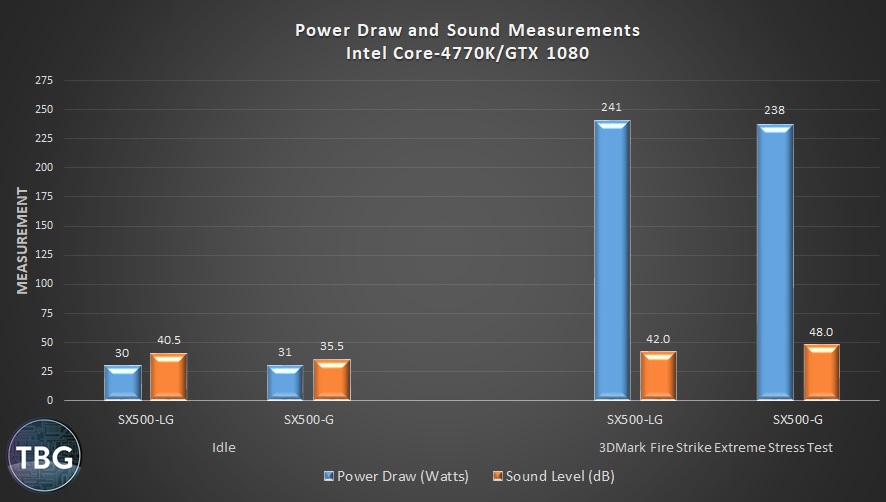
At idle, this unit wasn’t actually more efficient than the SX500-LG, which is not too surprising given that there’s just not much room to improve things when you’re only drawing around 30W. The big news is that it’s far quieter, dropping from 40.5db to 35.5db, which is simply a tremendous improvement. Note that the system had other fans in it (both our Reeven Steropes CPU cooler and GTX 1080 Founders Edition run their fans constantly), so in order to isolate noise from the PSU, we placed our noise meter 3″ from the fan grille, which in the RVZ02 chassis is conveniently exposed through the case panel. If you were to stand one meter away from these systems, you probably wouldn’t be able to distinguish which component was making extra noise, but you’d certainly know that the PC with the SX500-LG was louder.

Under stress, the tables turned slightly. Here, the SX500-G was actually a bit more efficient than the SX500-LG, drawing 3W less, but it was also much louder. We placed our ears right up against the PSU fans to verify what the sound meter was picking up, and it was clear that this was no fluke. The smaller 92mm in the SX500-G was clearly running at much higher RPMs than the 120mm unit in the SX500-LG. At left we’ve included an image of the fan profile that SilverStone published on its website and included on the SX500-G’s box. Based on our testing, we’d have to say this just isn’t accurate. There’s no way the fan was operating at under 1000RPM when our system was drawing around 250W.
Critical update: SilverStone confirmed to us after this review was published that the fan profile graph published on its website and shown on the SX500-G’s packaging is indeed incorrect. SilverStone provided us with the full data table, and we have created a fan profile graph that accurately reflects the actual fan behavior in the SX500-G, as shown below.

It turns out that during our testing, our system likely pushed the PSU up to 1401RPM, which is tripped once the fan exceeds 250W, so our hunch was right – it was not running at under 1000RPM. While we commend SilverStone for providing us with its proprietary data, we’re a bit disappointed that incorrect data made it onto the product packaging. Ultimately, the noise level is a bit of a disappointment, and this is one of the tradeoffs you must consider when packing this much power into a tiny enclosure. Remember, this wasn’t even at the ragged edge of the PSU’s power rating, but rather right at 50% load. To put this noise level in perspective, we measured our GPU fan and our CPU fan from a 3″ distance, and found our GTX 1080, which was loaded at 100% in this test, generated 46dB, while the CPU fan was running at 42dB. So at 48dB, the PSU was the loudest component in the system, and we’d wager that SilverStone probably could tighten up the fan profile a bit to get the noise level down until power draw and internal temperatures were closer to maximum. Then again, we’ve never known SilverStone to be the kind of company that takes a lot of chances with reliability.
Conclusion
Overall, we came away incredibly impressed by the SilverStone SX500-G. In its attention to detail, SilverStone has crafted a new SFX unit for the ages, and we have no doubt that it will remain on the market for years to come, just like SilverStone’s original Gold-rated SFX units released in 2012. With its more robust selection of ports and cables, a full 500W on the 12V rail, as well as its extremely quiet idle noise levels, it’s a great PSU pick for any compact system. We just wish that SilverStone could tweak the fan profile a bit to lessen noise at load, but otherwise, it’s really the ideal SFX power supply. Being that it has no serious SFX competition at the 500W output level, fair pricing becomes an open question, but its official MSRP of $100 is right in line with Corsair’s $90 SF450 and the $120 SF600, which seems fair to us, if not particularly aggressive.
The SilverStone SX500-G SFX Power Supply, which has just been released, is available for $104.99 shipped from Amazon, as of our publication date. While we think it’s more than powerful enough for any system you could run in an ITX enclosure, SilverStone also markets a higher-wattage version, the SF650-G, which is selling for $134.99 shipped from Amazon. It offers the most power you’ll find in any SFX power supply, in case you really want to crank your PC up to “11”!

